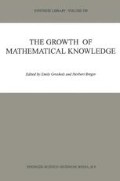Abstract
In the last twenty years, the issue of the “geometric algebra” of the ancient Geeks has been the subject of discussion by historians of mathematics. The key question that has attracted the attention of students of the mathematics of ancient civilizations has been whether “geometric algebra” was just a speculative construct of H.G. Zeuthen (1912) and P. Tannery (1930), who introduced modern notions into ancient mathematics, or whether these scholars managed to retrieve the true essence of the creations of the great Greeks.
Access this chapter
Tax calculation will be finalised at checkout
Purchases are for personal use only
Preview
Unable to display preview. Download preview PDF.
References
Bag, A. K. and Sen, S. N. (Transi.). (1983). The Sulbasutras of Baudhayana, Apastamba, katyayana and Manava. New Delhi.
Barabashev, A. G. (1985). “K probleme vozniknoveniya teoreticheskoi matematiki.” (“On the Problem of the Rise of Theoretical Mathematics: Methodological Problems of the Development and Application of Mathematics.”) in (1985, 177–87). Metodologicheskie problemy razvitiya i primeniya matematiki. Moscow: USSR Academy of Science.
Barabashev, A. G. (1999). “Evolution of the Modes of Systematization of Mathematical Knowledge.” In this volume. Pages 315–29.
Bashmakova, I. G. (1956). “Lektsii po istorii matematiki v drevnei Gretsii.” (“Lectures in the History of Mathematics in Ancient Greece.”) Istoriko-matematicheskie issledovaniya. (Historical- Mathematical Investigations.) Volume 11: 225–400.
Bashmakova, I. G. (1980). “Rol’ interpretatsii v istorii matematikii.” (“The Role of Interpretation in the History of Mathematics.”) Istoriko-matematicheskie issledovaniya. (Historical-Mathematical Investigations.) Volume 30: 182–94.
Bashmakova, I. G. and Vandoulakis, I. M. (1994). “On the Justification of the Method of Historical Interpretation.” Trends in the Historiography of Science. 249–64.
Berezkina, E. I. (1980). Matematika drevnego Kitaya (The Mathematics of Ancient China). Moscow: Nauka.
Freudenthal, H. (1977). “What is Algebra and What has it been in History?” Archive for the History of Exact Science. Volume 16: 189–200.
Gillon, B. S. (1977). “Introduction, Translation and Discussion of Chao Chun-Ch’ing’s ‘Notes to the Diagrams of Short Legs and Long Legs of Squares and Circles’.” Historia Mathematica. Volume 4: 253–93.
Needham, J. (1954). Science and Civilization of China. Vol. 3. Cambridge.
Neugebauer, O. (1957). The Exact Sciences in Antiquity. Providence: Brown University Press.
Sufiyarova, I.I. (1990). Indiiskay matematikav “Shulba-cutras” i trudakh arabkhaty I i bkhaskaryi (Indian Mathematics in the “Sulbasutras” and in the Works of Aryabhata and Bhaskara). Ph. D. Dissertation. Moscow: Moscow State University.
Tsian’ Bao-tsun. (1963). A History of Chinese Mathematics. Beijing: Kesiue Chuban’she.
Tannery, P. (1930). Pour l’histoire de la science hellénique. Paris: Gauthier-Villars.
Unguru, S. (1975–6). “On the Need to Rewrite the History of Greek Mathematics.” Archive for the History of Exact Science. Volume 15: 67–114.
van der Waerden, B. L. (1954). Science Awakening. Groningen: Noordhoff.
van der Waerden, B. L. (1975–6). “Defence of a “Shocking” Point of View.” Archive for the History of Exact Science. Volume 15: 199–210.
van der Waerden, B. L. (1983). Geometry and Algebra in Ancient Civilizations. Berlin: Springer Verlag.
Weil, A. (1978). “Who Betrayed Euclid?” Archive for the History of Exact Science. Volume 19: 91–3.
Yao Fan. (1995). Matematicheskie fragmenty iz tractata “Chzhou bi suan’ zin”; Kommentariya k nemu Chzhao Zun ‘-Tsina. (Mathematical Fragments from the Treatise “Zhou be suan ‘ zhin “ and Chao Chun-Ch’ing’s Commentary). Ph.D. Dissertation. Moscow: Moscow State University.
Zeuthen, H. G. (1912). Die Mathematik im Altertum und im Mittelalter. Leipzig-Berlin: Teubner.
Editor information
Editors and Affiliations
Rights and permissions
Copyright information
© 2000 Springer Science+Business Media Dordrecht
About this chapter
Cite this chapter
Bashmakova, I.G., Smirnova, G.S. (2000). Geometry: the First Universal Language of Mathematics. In: Grosholz, E., Breger, H. (eds) The Growth of Mathematical Knowledge. Synthese Library, vol 289. Springer, Dordrecht. https://doi.org/10.1007/978-94-015-9558-2_22
Download citation
DOI: https://doi.org/10.1007/978-94-015-9558-2_22
Publisher Name: Springer, Dordrecht
Print ISBN: 978-90-481-5391-6
Online ISBN: 978-94-015-9558-2
eBook Packages: Springer Book Archive

